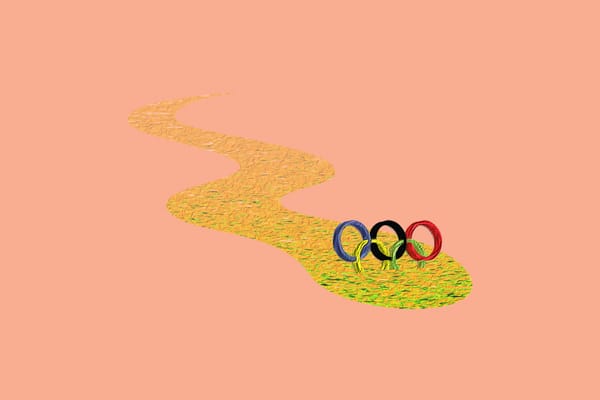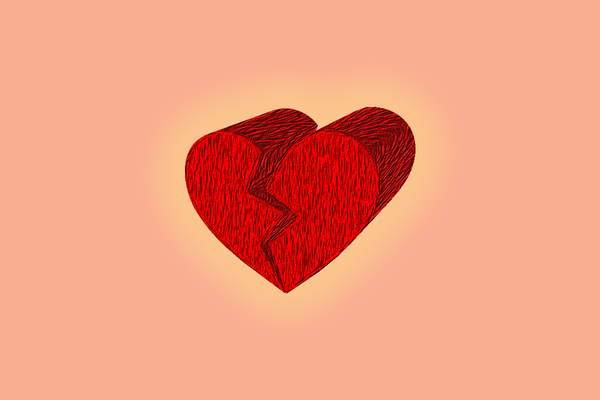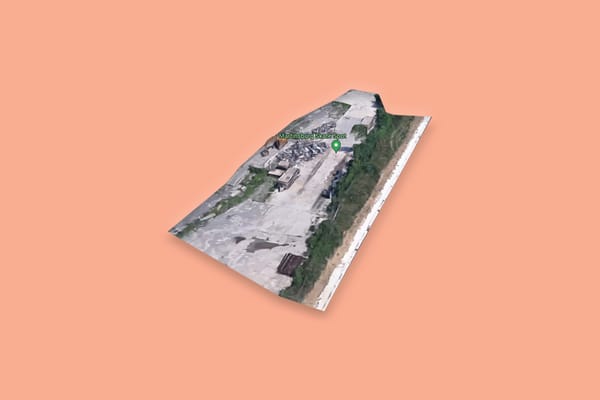Bobby, Bolang, and those bootleg boards
A special investigation.
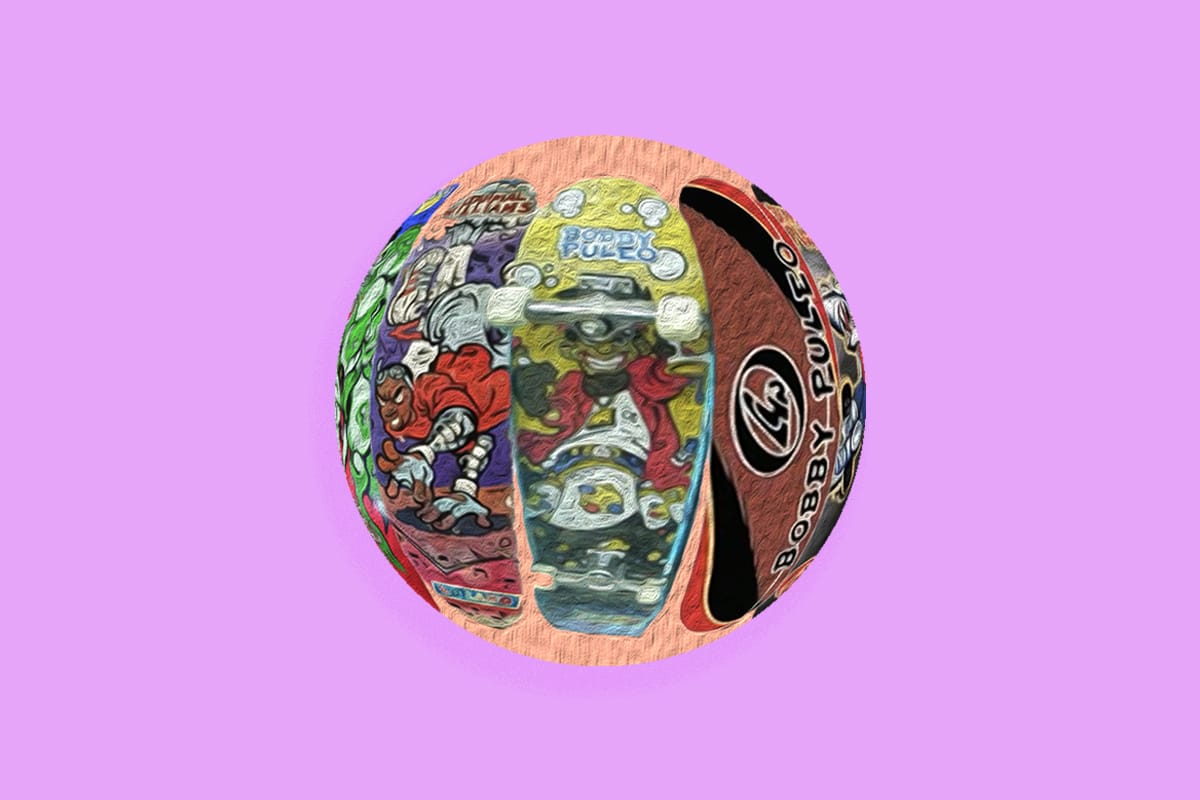
Being a victim of theft is a uniquely alienating experience. At first, it’s disorienting. Where is my thing? Did I misplace my thing? Then, once the reality of the situation sets in, paranoia takes hold. Who would steal my thing? Why would they steal my thing? Eventually, one starts to think of solutions. Do I ask for help in recovering my thing? Should I accept that what was once my thing is now gone forever?
When most of us have things stolen, it’s just that—we’re having things stolen. Items received or purchased. Physical belongings that can be held and, in most cases, replaced. A bicycle, a wallet, the Walkman left on your middle school desk during lunch hour that just up and left. However, one of the more insidious forms of theft is not of tangible objects but of those things that are extensions of ourselves.
The chance that you or someone you know have had their personal information scraped after falling prey to a phishing scam is surprisingly high. Gluttonous corporate entities like Urban Outfitters have a sordid history of stealing independent artists’ work. Most AI art generators pull from databases of millions of images used without permission to train their algorithms.
But it’s not often a person has their literal name stolen.
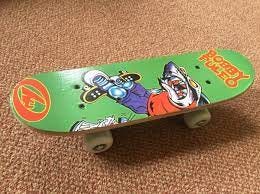
Pro AF (Ahh, Foreal?)
As the story goes, at the turn of the century, around 2001-2002, the girlfriend of Tino Razo’s brother Marc was in China for a modelling gig. When she returned to the United States, she had a gift in tow for their friend, professional skateboarder Bobby Puleo: one of his pro-model boards that she’d purchased while abroad. However, despite his name being plastered large and loud across it, this was not a Bobby Puleo pro-model skateboard.
Puleo would tell The Nine Club podcast in 2019 that the knockoff was made of cheap composite material and was of a lesser quality than even a NASH—the once ubiquitous Fort Worth, Texas-based brand that produced cheap complete skateboards for the toy sections of department stores, plastic trucks and all. (A fire would destroy the NASH manufacturing plant in 2006, effectively ending the company.)
To see this sub-standard board bearing his name without his consent or any financial kickback was a confusing turn of events for Puleo, and the skateboarding community in general, who’d start to document the faux Puleo products popping up around the globe and upload the images online. “Anybody in skateboarding that they could bootleg [their] damn name and it’s me?” Which was a reasonable thought for him to have. While Puleo had a profile in the industry at the time, he wasn’t a marquee name that you might expect a bootlegger to make knockoff products of. There’s a reason fake Gucci handbags continue to flood the market.
So why him? Puleo has a couple of theories. One is that when Infamous Skateboards—the New York City-based board company that he rode for from 1999 to 2001—went out of business, they “sold their backstock… probably to some toy [company] in China… [who] then just went into production with whatever was written on the boards.” Which would include the five unassuming syllables of Bobby Puleo.
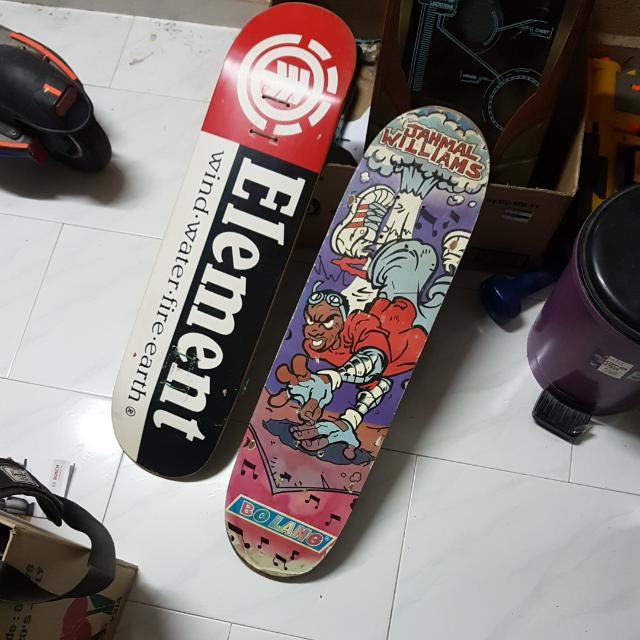
His other theory is that Infamous “sold a licensing thing because I know there was also a Jahmal Williams bootleg [board] that I had seen.” Williams, the founder of the venerable HOPPS Skateboards, was a former teammate of Puleo’s on Infamous. However, Williams’ bootleg didn’t catch on in the same way. They were obscure enough that when I reached out to ask for his thoughts on the pirated boards, Williams responded that he wasn’t familiar with the story.
Over the phone, Puleo told me that people still send him pictures of the “Bobby Puleo” boards as they continue to surface in various corners of the world. In just a few short keystrokes, you can find them in sketchy online marketplaces to this day. As he’d tell The Nine Club, “So Jahmal had it early on... But mine, for whatever reason, just stuck around.”
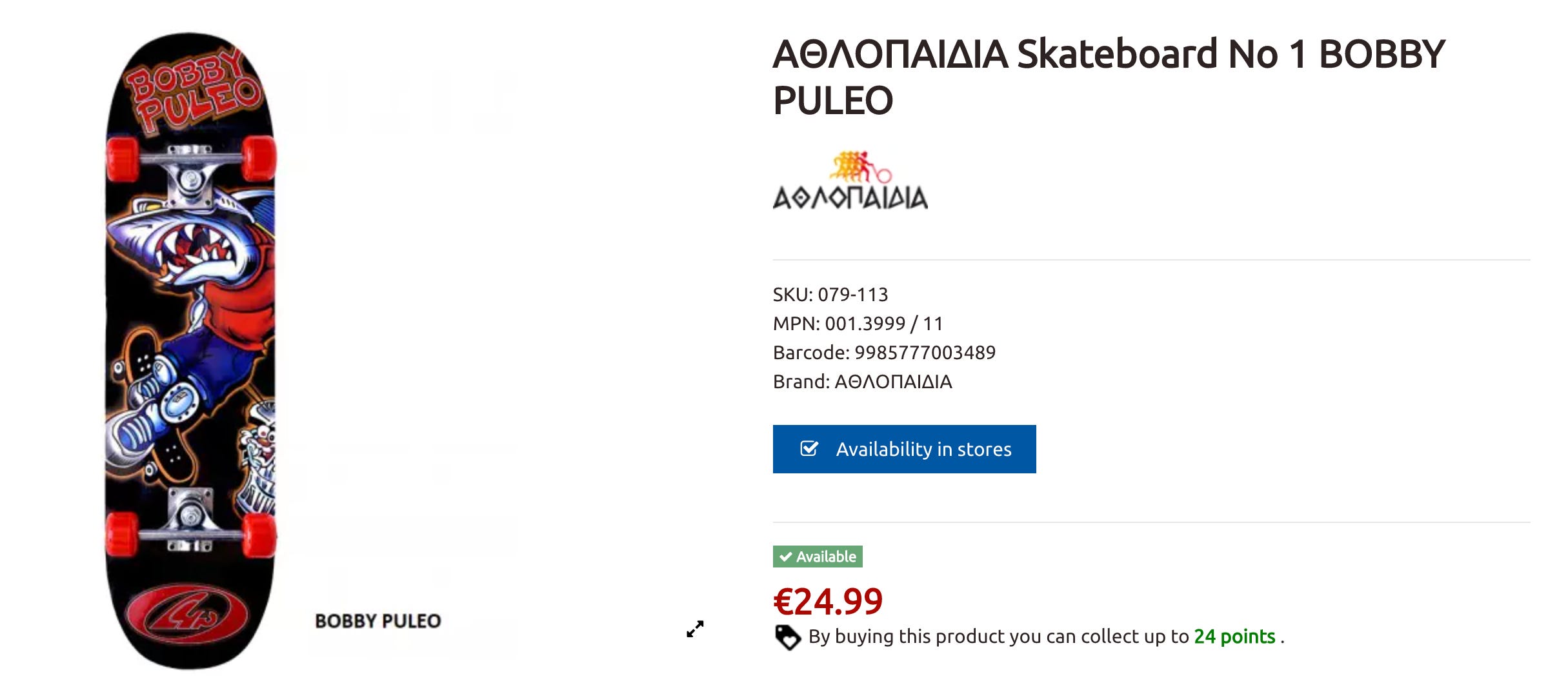
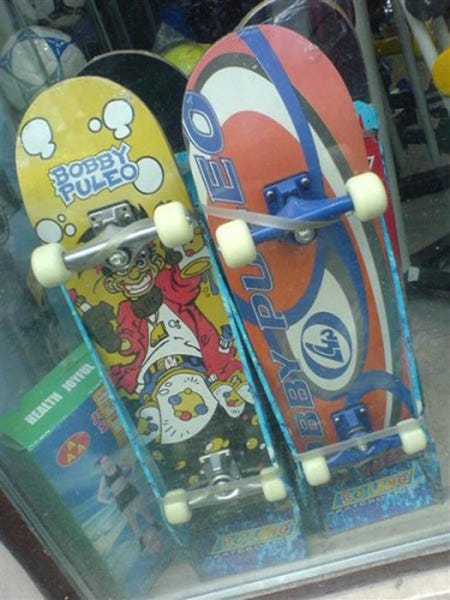
Meet your maker
So who has been manufacturing these off-brand “Bobby Puleo” skateboards for over two decades? That would be Bolang, a subsidiary company of the Guangdong, China-based Foshan Nanhai Jingqian Sporting Goods Co., Ltd. According to the latter’s Alibaba supplier account that was activated in 2018, they employ 51-100 people, have a yearly product output worth 5-10 million dollars, and detail their bona fides as “more than 20 years of making skateboards, basketball circles, football training supplies, and other sports supplies.”
The depth of their product catalogue is vast and includes various styles of skateboards, longboards, penny boards, helmets, pads, pylons, basketball hoops, backboards, and more. It’s a dizzying amount of stuff. Stuff of purposefully low quality to appeal to bulk purchasers looking to fill out the shelves of their stores without breaking the bank. Some of Bolang’s products are even affixed with the self-evident prefix “cheap.”
Operations like this aren’t unusual by any means. There are countless pricepoint Original Equipment Manufacturers (OEM) and Original Design Manufacturers (ODM) like Bolang who are simply reacting to and subsisting off our global appetite for junk. As bleak as that is, at least in some instances, Bolang seems to be getting creative. On top of their standard skateboards, they also sell things like a rather uncomfortable-looking “skateboard chair” and a curious “custom skateboard wall mount.”
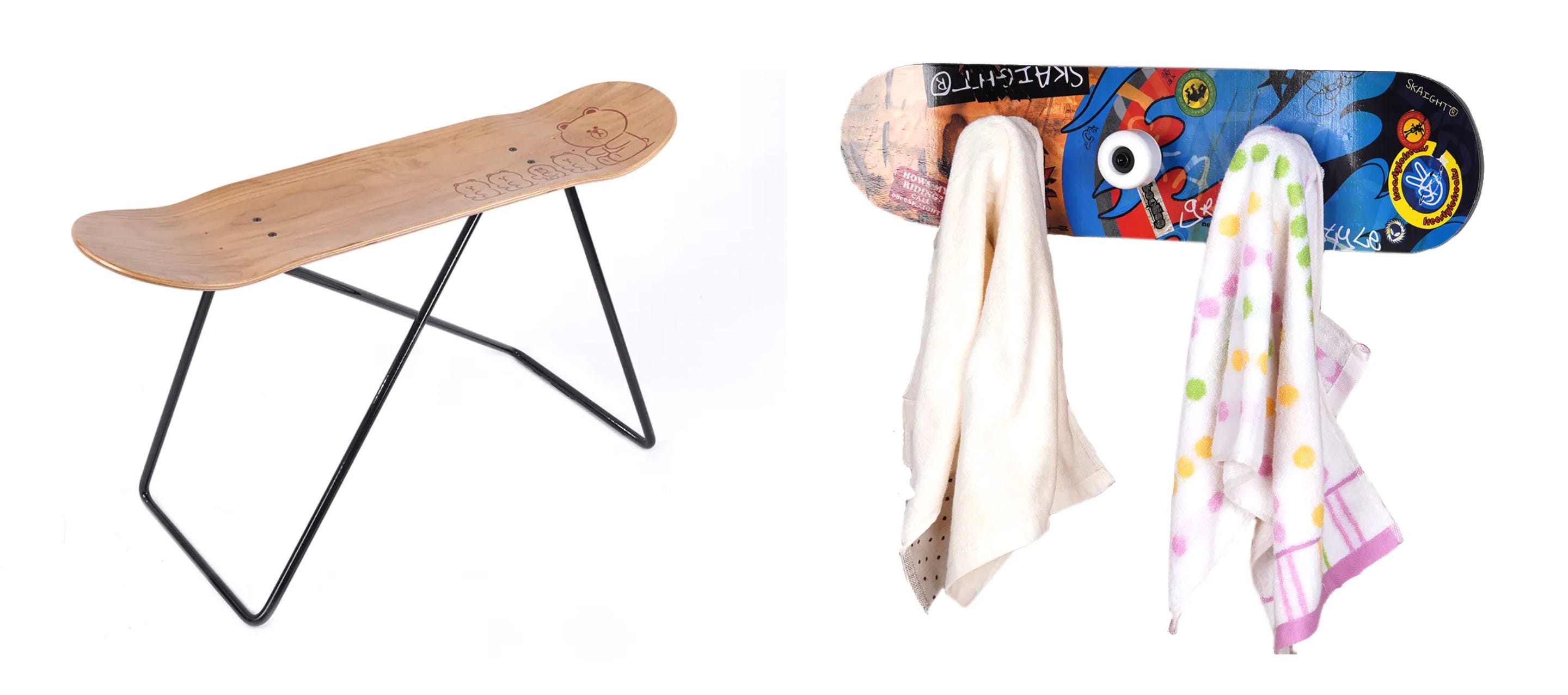
Sure, these products feel less like the result of innovation and market demand and more like the outcome of a directive to “figure out a way to sell this shit,” but it’s a good effort all the same.
The chair and wall mount, along with the regular skateboards, all come with the option of selecting a graphic for their undersides. If you wanted a shipment of the “double rocker skateboard for adults” (minimum order of 500 units [complete skateboards]), the library of graphics to choose from is quite extensive and includes a few familiar names.
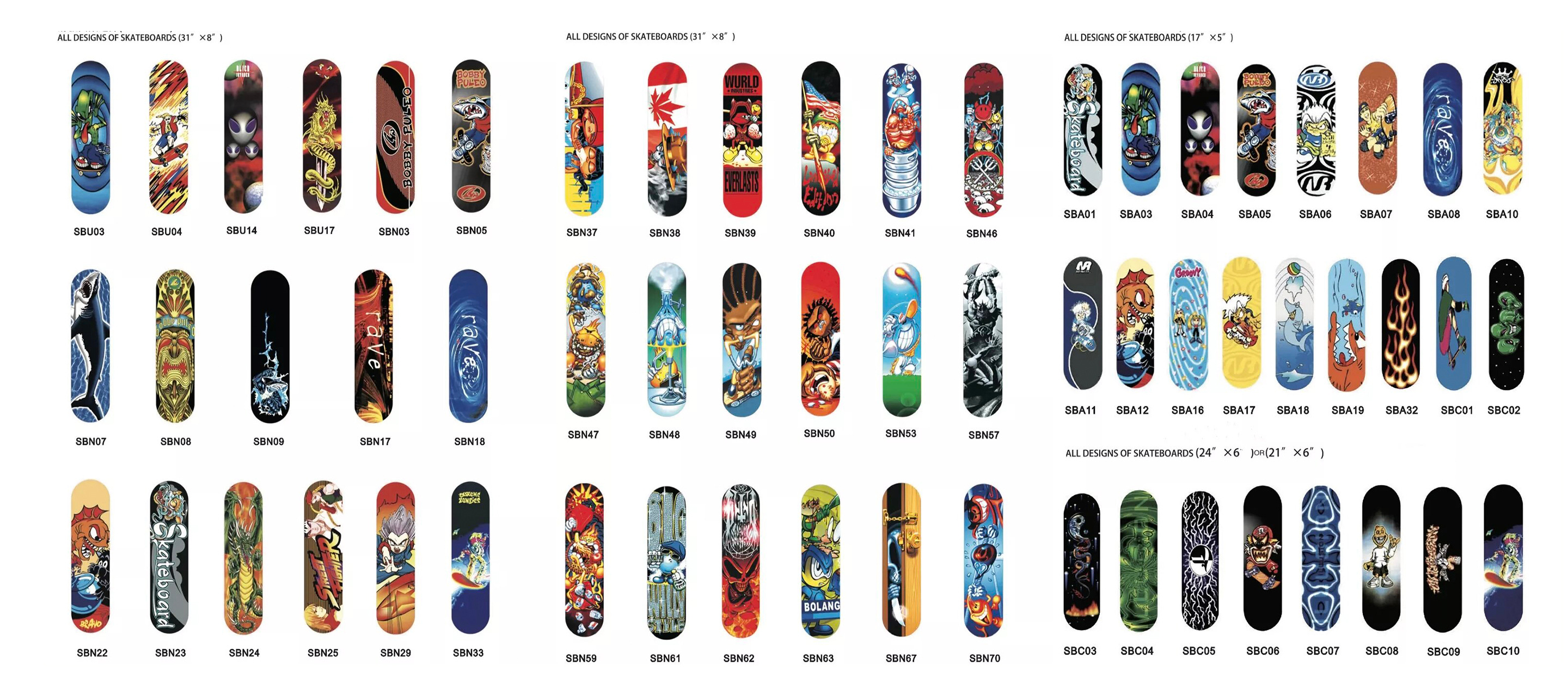
Among them, there are clear Street Fighter and Dragon Ball Z ripoffs (that could’ve used a bit more work if we’re being honest), a series of likely-lifted designs featuring several spokescharacters from the once-popular ‘90s brand No Rules, and in a particularly bold move, there are a number of late-‘90s World Industries and Blind Skateboards graphics that look (mostly) accurate to the original Flameboys, Wet Willys, and Reapers I pined over in my youth. I reached out to World Industries on the off-chance that they’d had a licensing arrangement with Bolang and was told that they would be “[notifying] our legal department as these are not authentic WI boards.”
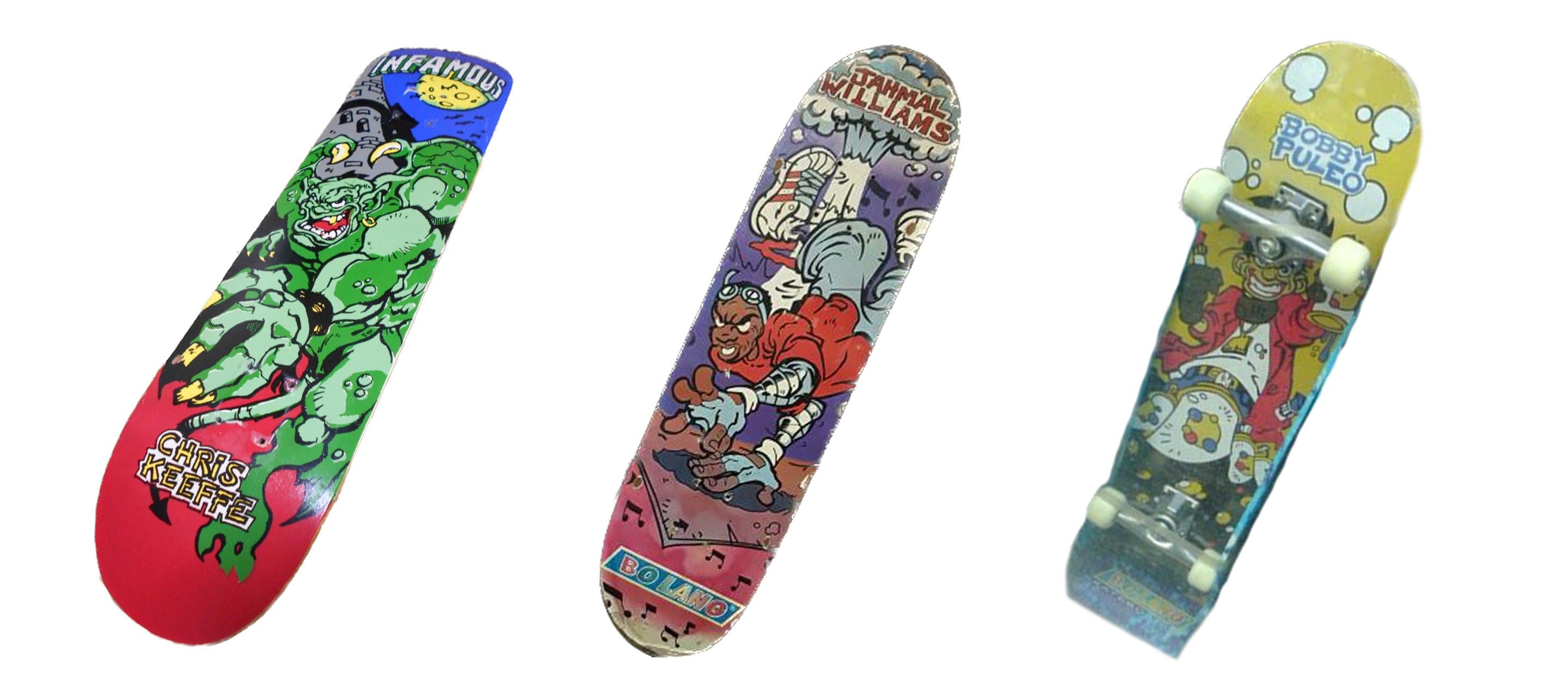
Then, of course, there are the “Bobby Puleo” graphics. From all accounts, the first iteration of these bootlegs was the Infamous “Urban Heroes” series knockoffs, with Puleo and Jahmal Williams’ models getting cribbed (a Chris Keeffe from the original collection is going for nearly $2,000 on eBay). The pair of graphics in Bolang’s current library, which are tagged SBN03 and SBN05, respectively, were the next evolution. These were no longer outright mimicries but whole new arrangements of presumably appropriated images and text.
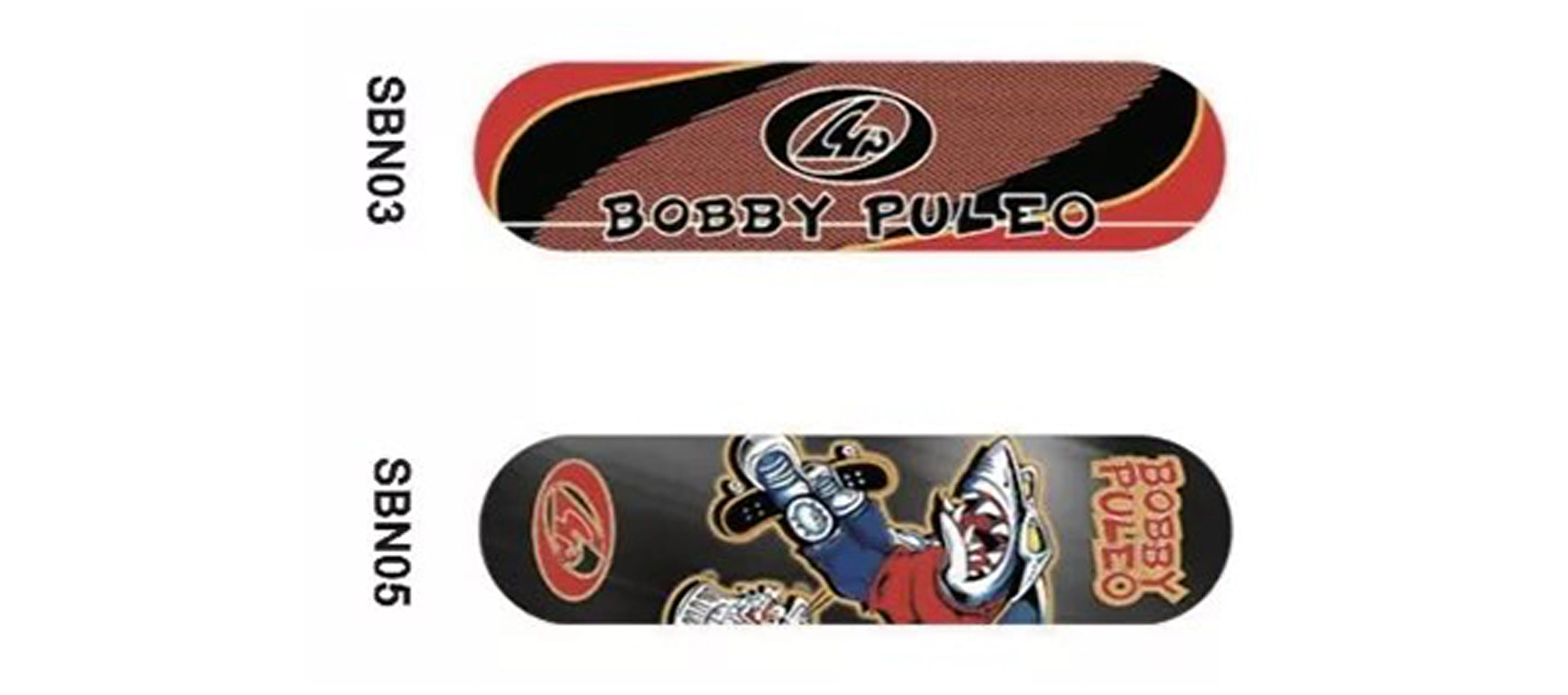
But the question remained: why Puleo? And to that end, why Infamous? Dragon Ball Z, World Industries, and Blind bootlegs all make sense—those were all incredibly popular in the late ‘90s and early ‘00s. Infamous was but a blip on the skateboarding scene. Stranger still, it’s in that era this graphics library continues to exist, seemingly un-updated since, meaning that the company has been selling the same graphics for over twenty years.
I reached out to Bolang with a request for an interview but did not hear back. However, I did use the chat function on their Alibaba supplier page to speak with a customer service representative and asked if their SBN03 and SBN05 graphics were in stock, which they confirmed and then promptly asked, “how many pcs do you want?” The customer service representative did not respond to my follow-up about who designed the graphics or how they came into association with one Bobby Puleo.
An Infamous end
As Puleo’s theories go, when his former sponsor Infamous Skateboards shuttered, it either sold off its backstock or image rights to Bolang, leading to decades worth of illegitimate “Bobby Puleo” completes dotting the aisles of toy stores and collecting dust in an untold number of parents’ crawl spaces. On its face, both theories seem feasible. When a company goes under, there’s usually some form of asset liquidation to try and recoup losses or pay off debts. But figuring out how to prove it was another thing. With Bolang unwilling to talk about the origins of their graphics, the only link left to explore was Infamous itself.
There’s not a lot of publicly available information about the short-lived, long-defunct board brand, which ran from 1997-2001. Keyword searching around the internet will show you the “INFMS” (2000) video (which holds up quite well to this day), a spate of magazine ads from the time, a few board graphics, and even fewer details about the history of the company and who ran it.
From what you can find, Infamous is usually referred to as the project of former team riders Ben Liversedge, Mike Hernandez, Ryan Hickey, and some people behind the scenes who had managed to secure financial backing for the company from Vans. They would build a team that, at different points, included the likes of Nikhil Thayer, Geo Moya, Andrew Bautista, Matt Bell, Ian Reid, Samir Krim, Jahmal Williams, and Bobby Puleo. In 2000, the company attempted its only official tour, a notorious affair that ended after only two stops and the trashing of a hotel. This would ultimately lead to nearly half of the team getting the boot. That tour is often attributed as triggering the demise of the brand.
However, in his Chromeball interview from 2016, a prickly Hickey claims that wasn’t the inciting moment and he was actually responsible for the fall of Infamous, or at least its backing from Vans.
According to Hickey, not long after the aborted tour, he and a few of his remaining Infamous teammates went to a contest in New Jersey. One evening, after reaching a mutual drunken stupor with Matt Bell, they stumbled into the hotel room of Chris “Dune” Pastras, co-founder of Stereo Skateboards, a company Hickey had recently been kicked off of. After a time spent “vibing” Pastras, they left, returning later to find the door unlocked and his room empty.
Inside was a video camera they assumed belonged to Deluxe Distribution (who carried Stereo at the time). They’d nab it, make their way to a pier, and toss it into the Atlantic Ocean as a “fuck you” to his former sponsor. It turns out the camera actually belonged to Vans, and apparently, there was footage of Mark Gonzales on it. “So yeah, we fucked that up,” Hickey admits.
In the same interview, he reserves little mercy for Infamous, saying the initial offer from Mike Hernandez and Ben Liversedge to take part in the project “sounded too good to be true” and that Infamous was “…just one nightmare after another. The products were horrible, all those guys did was lie, they were always changing my board graphics… The whole shit was horrible.”
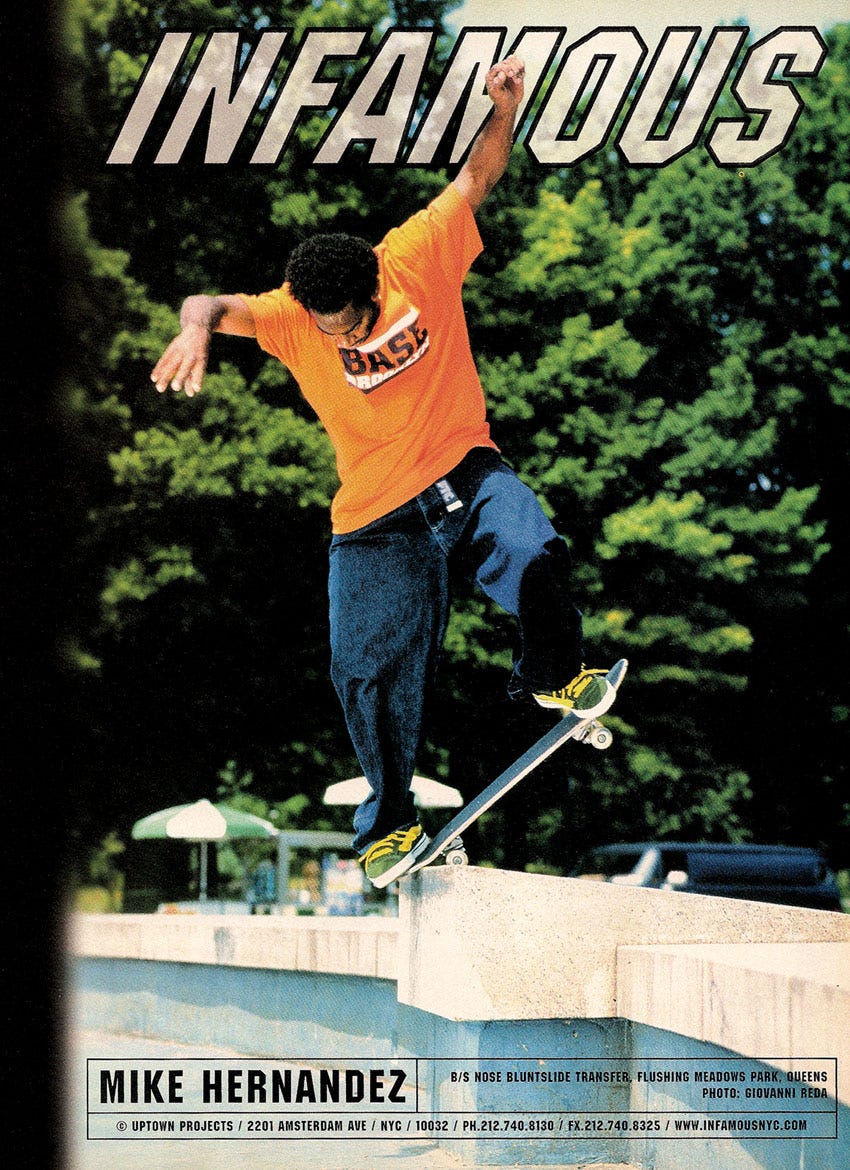
I’d reach Hernandez by phone, and he’d tell me that things began well enough with Infamous. Initially, he and Liversedge had been approached by a stranger at a trade show who wanted to start a board company. They heard out his pitch, agreed to come aboard, Liversedge would come up with the name, and off they went. According to Hernandez, Infamous was supposed to be a creative partnership between the group. But, as Hickey also lamented, that partnership would soon become one-sided.
The team would receive proofs of board graphics they thought they’d all agreed on, only to find the colourways swapped or designs themselves changed. The same would happen with apparel. The people behind the scenes had also started taking out ads in all of the major skateboarding magazines of the time, a firehouse approach to marketing that Hernandez felt was antithetical to the more underground image he and the team riders wanted to cultivate at a steady and natural pace.
Hernandez would become disillusioned with the brand and how it was being operated. The camera-stealing incident was the tipping point, and he’d quit Infamous shortly after. He would eventually stop pursuing professional skateboarding as a career altogether and take up firefighting. He’s been with the FDNY ever since and was promoted to lieutenant in 2021. Reflecting on spending twenty years skateboarding followed by another twenty fighting fires, Hernandez laughed, “My body hurts and I’m fucking tired.”
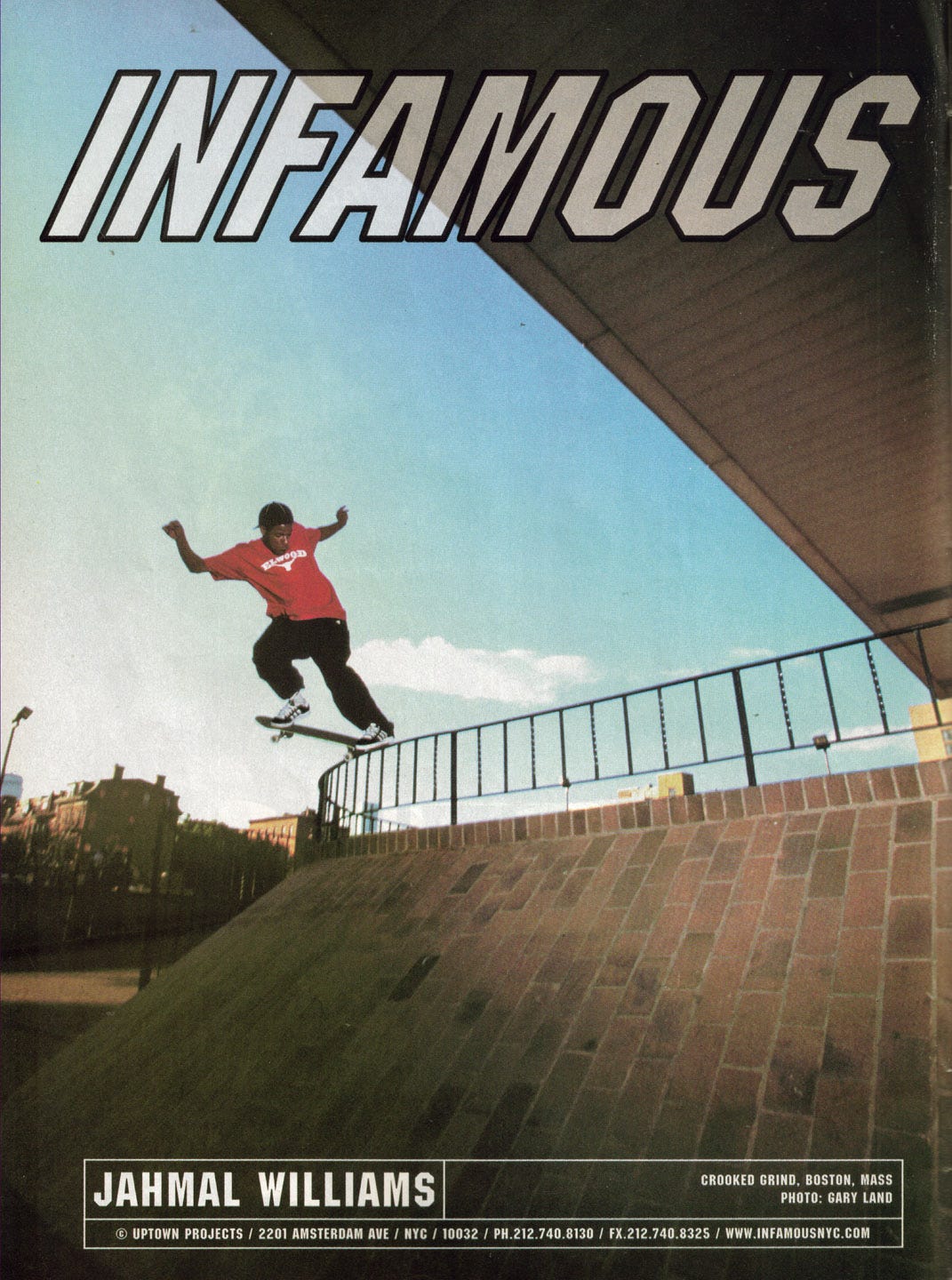
While their memories aren’t as caustic as Hickey’s, Jahmal Williams and Bobby Puleo seem mostly aligned with Hernandez: the initial intention behind Infamous was good, but the execution was off. Williams would tell Bobshirt in 2015 that “Infamous was dope. It was fun. It was cool. We were trying to do it.” Which is a more diplomatic take than in his Chromeball interview from 2011.
“They were trying to do something good on the East Coast and it seemed like a good idea. I think it didn’t work out because there was people involved behind the scenes that didn’t really appreciate the realness and true spirit of skateboarding. I believe their motivation was more about finance.”
Puleo was similarly blunt in his Chromeball interview in 2013. “…it was run behind the scenes by a bunch of non-skateboarders. I liked those dudes, but my God, talk about doing everything ass backwards.”
So who were these “non-skateboarders” behind the scenes? After some digging, I got in touch with Mike Failla, the founder of Infamous Skateboards. Over the phone, he’d tell me that he’s originally from Vermont, where in the mid-’90s, he’d start the lesser-known Freedom Skateboards and Blue Light Wheels under the umbrella of Uptown Projects.
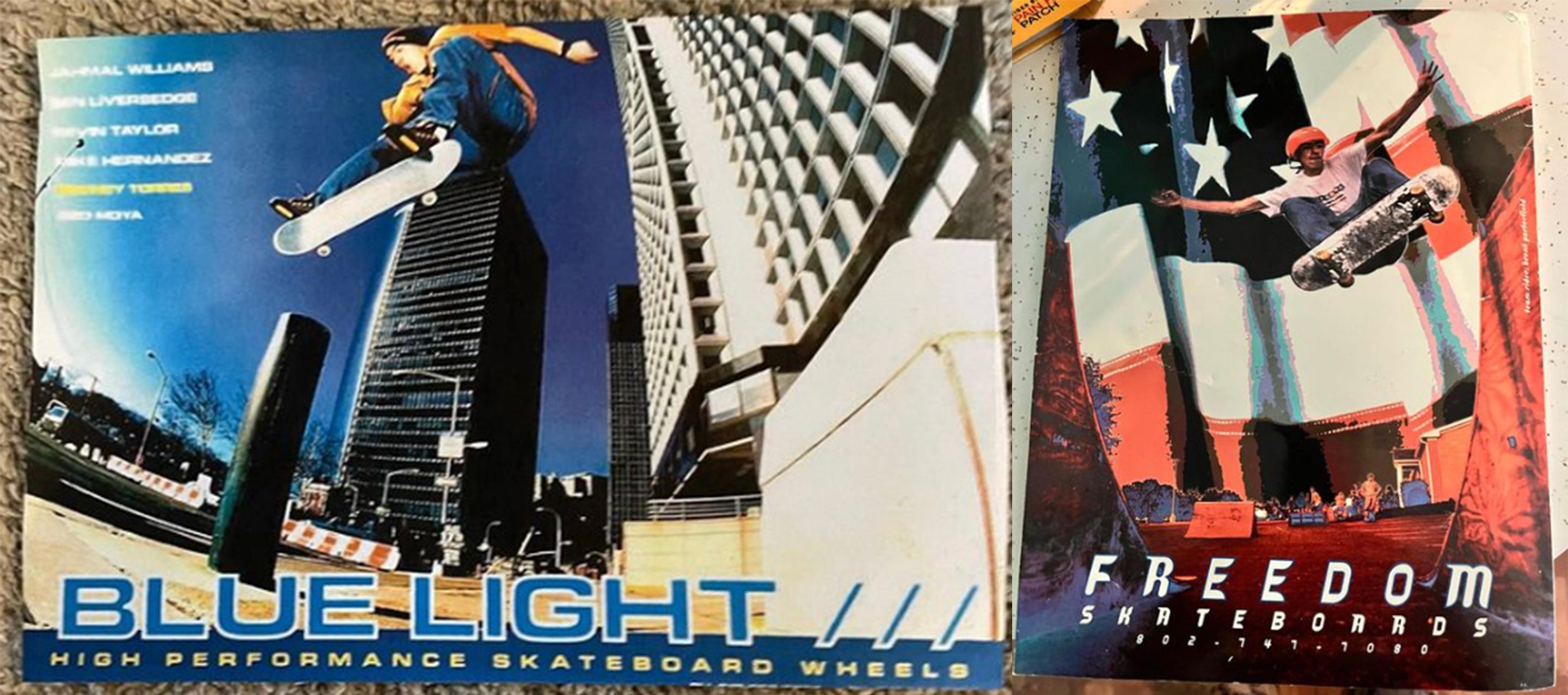
As Failla tells it, eventually, a friend would connect him with Vans, who was looking to start a board company as a way to Trojan horse themselves into the New York market, one they’d struggled to break into. He would get Hernandez and Liversedge involved as the faces of the brand, and they’d bring in Hickey and the rest of the team. Chapman was tapped to press their boards, and thus, the quick tumultuous life of Infamous Skateboards began.
While Failla would say he felt disrespected at being called a “non-skateboarder” by Puleo and others who’d criticized the brand in the past (he’d tell me that he is first and foremost a skater), it’s now water under the bridge. Time and the distance it affords—along with a recent chat with Puleo—can do that. However, he’d also tell me that the reasons his old team riders have less-than-rosy memories are more complicated than their comments would make it seem, and those reasons did involve “non-skateboarders.”
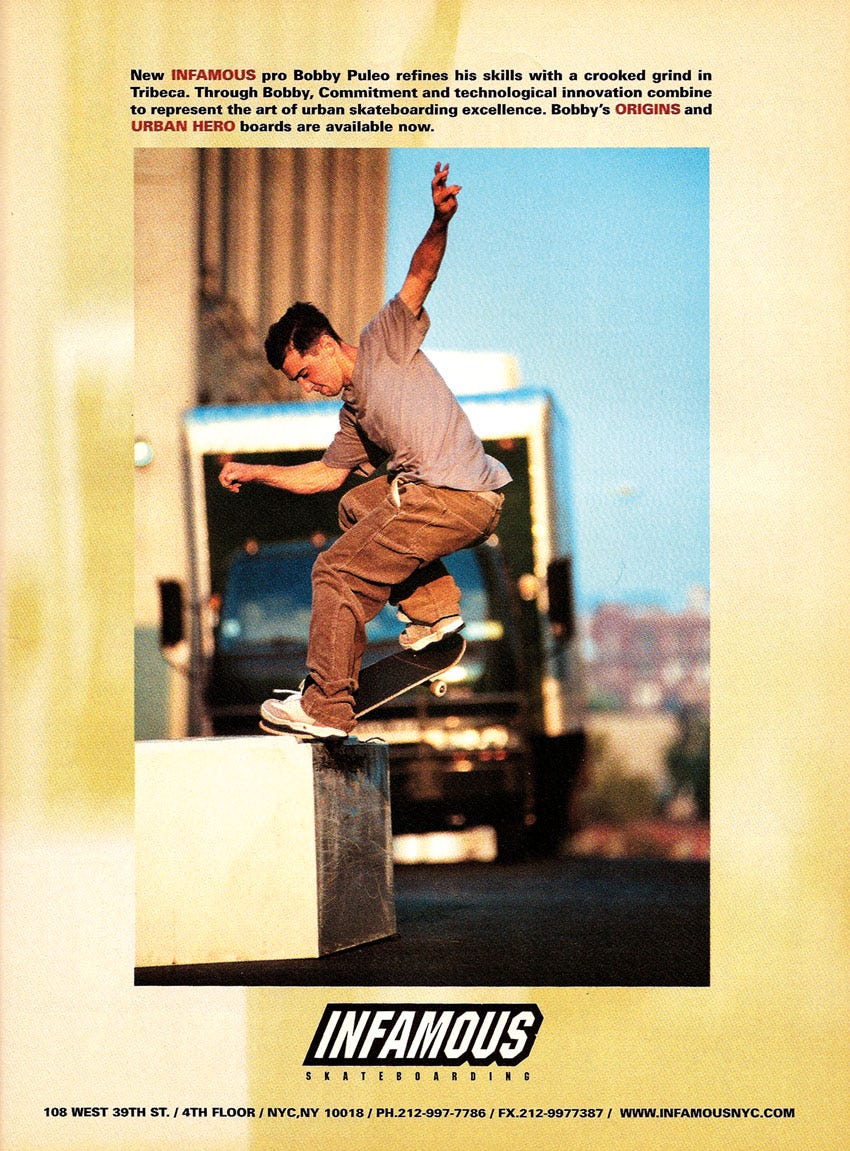
Failla would confirm that Ryan Hickey and Matt Bell’s theft and submerging of Vans’ camera led to the footwear giant pulling their funding from Infamous. Once that money was gone, he needed help to keep things running. At the time, Failla was also associated with an obscure hip-hop and action sports magazine called Fridge, which had served as a sort of defacto promotional arm for Infamous, with many of its team riders getting interviews and photos within its pages. He’d tell me that the people behind the magazine offered to help keep Infamous afloat for a stake in the company.
This would come at a cost, as he says he’d start to lose control of the brand’s creative direction. To him, the “Urban Heroes” series was a particularly egregious example. Allegedly the work of a friend (or cousin) of DJ Green Lantern, the cartoon caricatures were a stark departure from Infamous’ traditionally clean and simple designs. Puleo would tell me that he disliked them so much he asked Failla not to release them. But Failla said he had no choice in the matter. It’s what his new partners wanted and they thought the series would do big numbers.
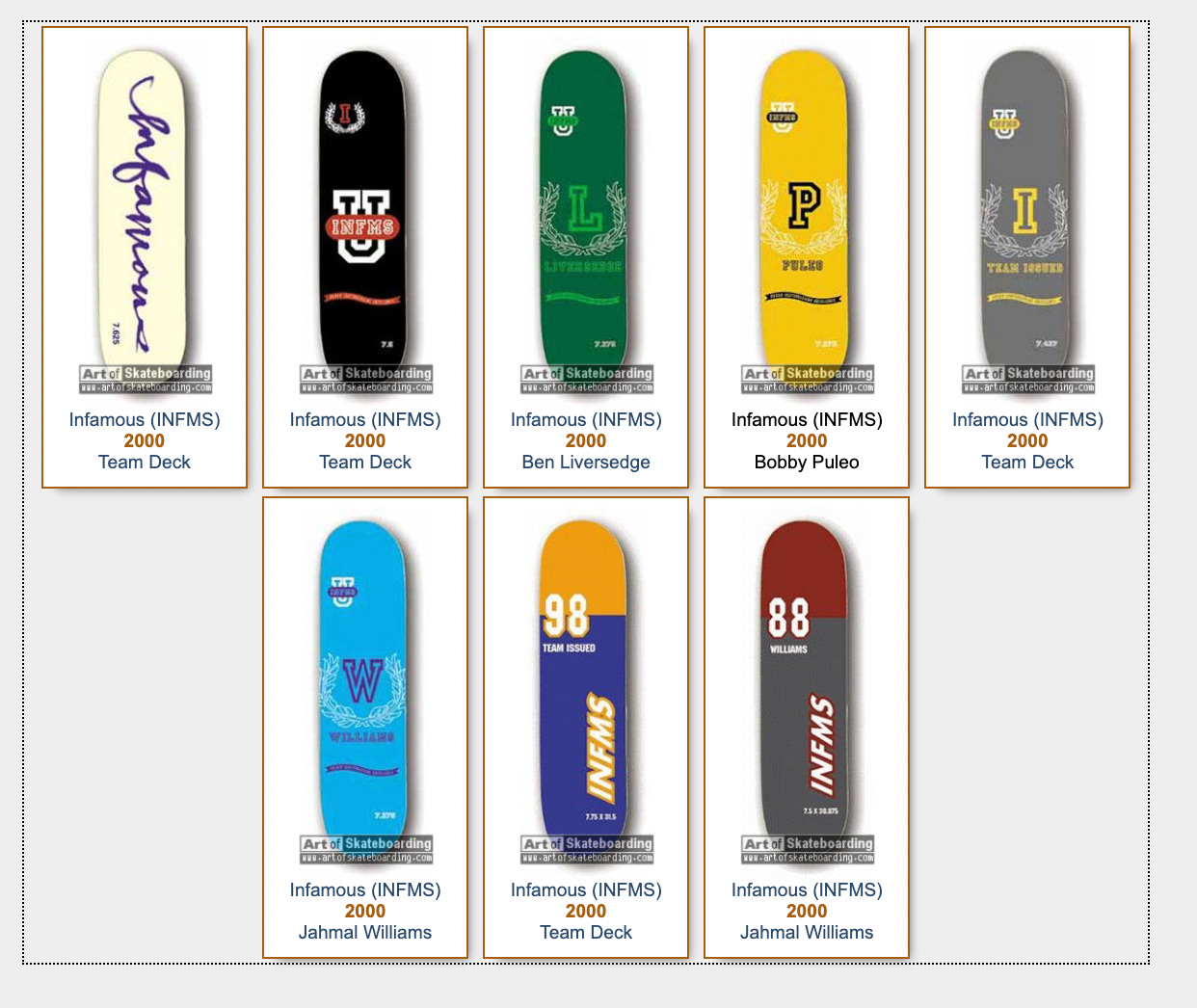
They’d be wrong. Failla says that he got “clowned” at trade shows by others in the industry when he showed up with the “Urban Heroes” boards. He also claims that the series sold so poorly that they had to do a “fire sale” of the unsellable stock to a distributor in Hong Kong to help recoup their losses. This distributor was rumoured to be a regular destination for board brands at the time who couldn’t sell their product by traditional means.
And it’s here where Failla’s and Puleo’s theories about the bootleg boards meet. Failla thinks Bolang likely came across the Infamous boards the Hong Kong distributor was selling on the mainland for cheap and decided to rip off the “Urban Heroes” series and Puleo’s name from there. While he balked at the idea that Infamous’ image rights were sold to Bolang as Puleo also theorized, he doesn’t know for sure what happened once he left the company in early 2001, saying it would stay under the stewardship of his partners from Fridge for another six months before collapsing. Whatever the case, it was an unfortunate end for Infamous, a company that many on the outside thought had the potential to be something special in skateboarding.
Failla now works in the cannabis industry and seems to enjoy this new direction in life. After recently coming across positive reactions online to the brand he helped create all those years ago, he’s started posting snippets about the Infamous and Fridge Magazine days on Instagram. Some of those memories still have sharp edges.
“This graphic will forever haunt me…” reads the caption under a photo of Chris Keeffe’s “Urban Heroes” pro model.
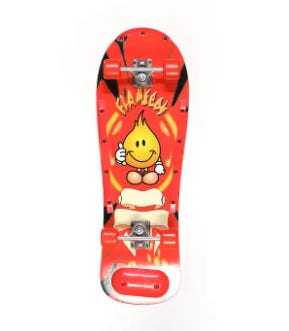
A moment of speculation
Right now, I can’t say with certainty how Bolang’s bootleg “Bobby Puleo” boards came to be. If I could find out the name of the distributor in Hong Kong who Failla says purchased Infamous’ “Urban Heroes” series backstock, that could potentially lead to an answer. The people who’d know best are Failla and his former partners at Fridge Magazine, who’d overseen Infamous’ final breaths. But he declined to share with me the names of the distributor or his partners, citing personal reasons. I’d eventually learn that someone named Jonathan Levine was, according to their LinkedIn page, the “Founder/Publisher/Editor In Chief/Creative Director” of Fridge from 1995-2002. I sent Levine a request for an interview but didn’t hear back.
While in a bit of a rut, I decided to take another look at the Alibaba supplier page of Bolang’s parent company, Foshan Nanhai Jingqian Sporting Goods Co., Ltd. Their business profile says they’re a manufacturing facility based on the mainland in Guangdong, China, which would presumably rule them out as the Hong Kong-based “distributor” Failla had mentioned. However, after poking around a little further on the site, I found an undated promotional photo from what looks to be a trade show Bolang participated in.
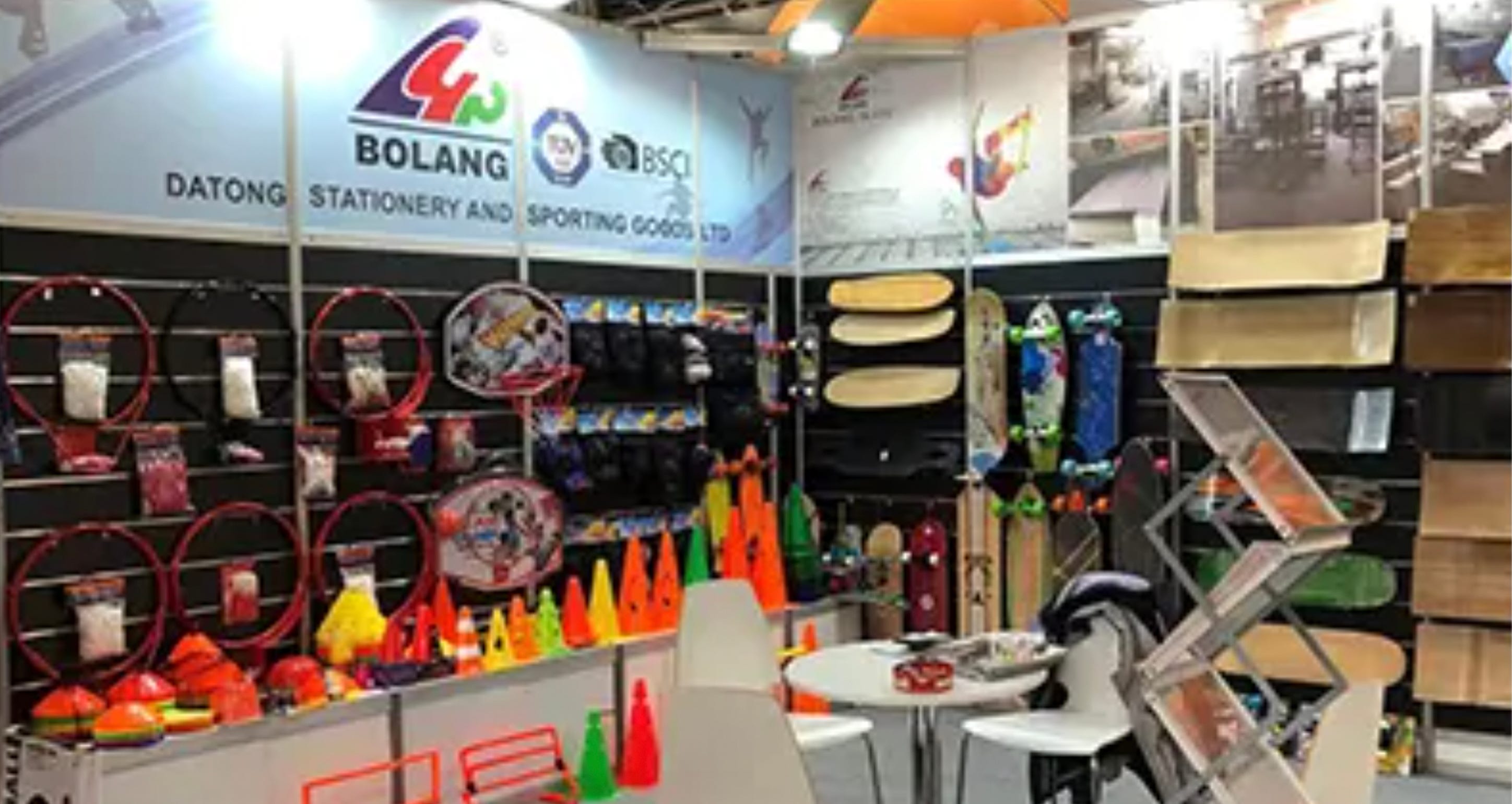
In the image, underneath a large Bolang logo on the wall of their trade show booth, it says “Datong Stationery and Sporting Goods Ltd.” A search of Chinese business directories showed that Datong Stationery and Sporting Goods Ltd. shares a phone number with Foshan Nanhai Jingqian Sporting Goods Co. and that Datong’s defunct URL (skateboardchina.cn) is nearly identical to Jingqian’s current one (skateboardchina.en.alibaba), making it clear that these entities were the same.
But most interestingly, a directory revealed that up until at least 2017, Datong had an office in Hong Kong. It appears that when Bolang’s parent company opened its Alibaba supplier account in 2018, it also changed its name from “Datong Stationery and Sporting Goods Ltd.” to “Foshan Nanhai Jingqian Sporting Goods Co.” and let go of the Hong Kong office in the process. That space is currently occupied by a company that sells air purifiers.
Could this mean that Datong Stationery and Sporting Goods Ltd. had a distribution arm in Hong Kong before changing names and getting into bed with Alibaba, which now appears to do the distribution for them? Was this proof that Bolang was the “distributor” Infamous initially dumped its stock onto, eventually leading to the creation of the bootleg boards and filling in this story’s last missing piece? Eh, maybe. I can’t say for sure at this point, but it would give some credence to the idea. It could also explain why Bolang produces dated World Industries, Blind, and other bootleg graphics if it’s to be believed that this was the place buying brands’ deadstock in the ‘90s.
While still speculative, for now, this seems as close as we’ll get to the genesis of this curious footnote in skateboarding history. The lifespan and legacy of these bootleg boards now extend far beyond the originals,’ even if those names Bolang took from them were then swallowed and rendered meaningless onto crude composite by their manufacturing line. A grim reality, but there’s no malice in it. This is simply a natural function of the relentless, gorging beast that is rampant global capitalism. And really, all it’s doing is exactly what we’ve taught it to: make as much money as you can by selling the most dogshit products possible.
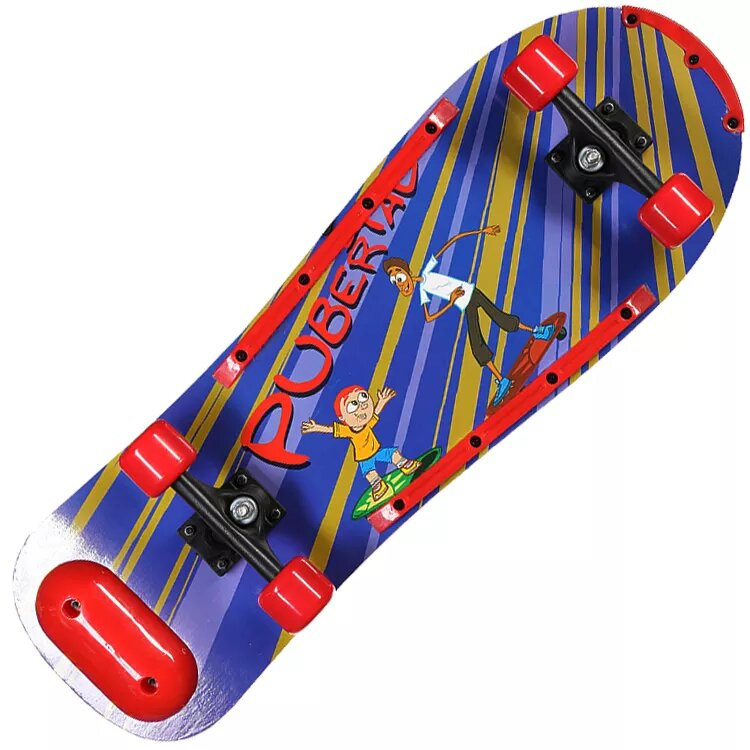
Is having your name taken in this way the same alienating experience as having a physical thing stolen from you? Puleo told me that, at first, he didn’t believe it had happened. How could these boards be real? He saw himself as a bit player in the scene at the time, an inexplicable target. Why not Andrew Reynolds or Geoff Rowley? After our phone call, he’d text me. I wonder if I can sue them.
After twenty-some-odd years, was there any realistic recourse he could take? It seems unlikely. He does have an idea, though: make bootlegs of the bootlegs and sell them through his brand TIM&VIC. Compared to the Bolang “Bobby Puleo” boards, the genesis of these was much easier to explain.
“I think it’d be really funny.”


